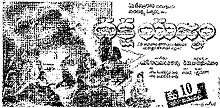Dakshayagnam (1962 film)
| Dakshayagnam | |
|---|---|
 Theatrical release poster | |
| Directed by | Kadaru Nagabhushanam |
| Produced by |
Kadaru Nagabhushanam Kannamba (Presents) |
| Written by | Aarudhra (dialogues) |
| Starring |
N. T. Rama Rao Devika |
| Music by | Saluri Hanumantha Rao |
| Cinematography | Lakshman Ghore |
| Edited by | N. K. Gopal |
Production company |
Varalakshmi Pictures[1] |
Release date |
|
Running time | 157 mins |
| Country | India |
| Language | Telugu |
Dakshayagnam (Telugu: దక్షయజ్ఞం) is a 1962 Telugu mythological film, produced and directed by Kadaru Nagabhushanam under the Varalakshmi Pictures banner.[3][4] It stars N. T. Rama Rao and Devika in the lead roles,[5] with music composed by Saluri Hanumantha Rao.[6] This was N. T. Rama Rao's 100th film which was also dubbed in Tamil with the same title.[7]
Plot
The film begins with Daksha Prajapathi (S. V. Ranga Rao) becoming the king of the Prajapathis, all gods give him most effective powers and an oath that no one will cross his words, he is blessed with 2 sons and adopted 27 girls, after that the Adi Parashakti was born as his daughter in the form of Sathi (Devika), who is the greatest devotee of Lord Shiva (N. T. Rama Rao). Daksha performs his 27 daughters' marriage with Chandra (Rama Krishna), after the marriage, Chandra spends his quality time only with Rohini (Rajasri) and ignores the others. Knowing this, Daksha cursed Chandra to die of the disease TB. Chandra prays to Lord Shiva and gets a boon that he will protect him, there arise clashes between Shiva and Daksha and war arises between them, where Lord Vishnu appears and makes a compromise by making Chandra into two parts. From that time Daska maintains his grudge against Lord Shiva; when he comes to know his daughter Sathi is in love with Shiva, he seeks another alliance for his daughter.
But Sathi marries Shiva against her father’s wish. Daksha attempted to insult Shiva by performing a sacrifice and neglecting to invite Shiva. Sathi wanted very much to attend the sacrifice. Ignoring the advice of her husband, she went uninvited to the sacrifice, where she had to endure many insults. At last, when Daksha started insulting her husband, she could not bear it any longer and immolated herself in the sacrificial fire. When Shiva heard of his wife's death, he makes a ferocious dance called Rudra Thandava and wakes up Veerabhadra from his hair, who attacks the guests at sacrifice and ended up decapitating Daksha. At last, on request of Daksha's wife Vairini (Kannamba) Shiva forgives Daksha and brought him back to life giving him goat's head instead of his own.
Cast
- N. T. Rama Rao as Lord Shiva
- Devika as Sathi Devi
- S. V. Ranga Rao as Daksha
- Chittor V. Nagaiah as Dadhichi Maharshi
- Rajanala as Indra
- Ramakrishna as Chandra
- Mikkilineni as Lord Brahma
- Padmanabham as Daksha's Younger son
- Suri Babu as Nandi
- Raghuramaiah as Narada Maharshi
- Balakrishna as Daksha's Elder son
- Dr. Sivaramakrishnaiah
- Kannamba as Vairini
- Rajasree as Rohini
- Chayadevi
- Meena Kumari
- Vasanthi
Crew
- Art: Thota Venkateswara Rao
- Choreography: Pasumarthi
- Stills: D. Radhakrishna Murthy
- Dialogues - Lyrics: Aarudhra
- Playback: P. B. Srinivas, P. Susheela, P. Leela, Jikki, S. Janaki, Jamuna Rani, Madhavapeddi Satyam, Radha Jayalakshmi
- Music: Saluri Hanumantha Rao
- Editing: N. K. Gopal
- Cinematography: Lakshman Ghore
- Presenter: Kannamba
- Producer - Director: Kadaru Nagabhushanam
- Banner: Varalakshmi Pictures
- Release Date: 10 May 1962
Soundtrack
| Dakshayagnam | |
|---|---|
| Film score by Saluri Hanumantha Rao | |
| Released | 1962 |
| Genre | Soundtrack |
| Length | 53:13 |
| Producer | Saluri Hanumantha Rao |
Music composed by Saluri Hanumantha Rao. Lyrics were written by Aarudhra. Music released on Audio Company.
| S.No | Song Title | Singers | length |
|---|---|---|---|
| 1 | Namo Namo Nadaraja | Madhavapeddi Satyam | 4:50 |
| 2 | Jabilli Ohoho Jabilli | P. B. Srinivas, Jamuna Rani | 3:08 |
| 3 | Hara Hara Mahadeva | P. Suri Babu | 4:06 |
| 4 | Koyila Thelupavate | P. Susheela | 3:38 |
| 5 | Idhi Chakkani Lokam | P. B. Srinivas, S. Janaki | 3:33 |
| 6 | Nee Pada Samseva | P. Leela | 3:02 |
| 7 | Kaanaru Nee Mahima | Raghuramaiah | 2:56 |
| 8 | Emi Seyudu Devadeva | P. Leela | 3:20 |
| 9 | Karunaamoorthulu | Raghuramaiah | 1:34 |
| 10 | Navarasa Bhavala | P. Leela, Radha Jayalakshmi | 5:33 |
| 11 | Pasuvaa | Madhavapeddi Satyam | 1:00 |
| 12 | Kamaneeyam Kailasam | P. Susheela | 2:56 |
| 13 | Girija Kalyanam | P. Suribabu, Madhavapeddi Satyam, Raghuramaiah, P. Susheela | 13:15 |
| 14 | Mangalam Mahaniya Teja | M. Mallikarjuna Rao Bhagavathar | 0:22 |
1941 film
Dakshayagnam was made for the first time in 1941 directed by Chitrapu Narayana Murthy.
References
- ↑ "Dakshayagnam (Overview)". IMDb.
- ↑ "Dakshayagnam (Release Date)". Spicy Onion.
- ↑ "Dakshayagnam (Banner)". Chitr.com.
- ↑ "Dakshayagnam (Direction)". Filmiclub.
- ↑ "Dakshayagnam (Cast & Crew)". gomolo.com.
- ↑ "Dakshayagnam (Preview)". Know Your Films.
- ↑ "Dakshayagnam (Review)". The Cine Bay.